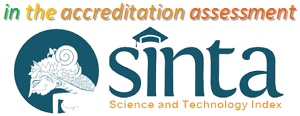Optimization of Melanoma Skin Cancer Detection through Data Magnification, Filter Preprocessing, Image Enhancement, and Convolutional Techniques
DOI:
https://doi.org/10.37034/medinftech.v3i3.48Keywords:
Convolution, Data Magnification, Image Enhancement, Melanoma, Skin Cancer DetectionAbstract
Melanoma skin cancer is one of the most aggressive forms of cancer, requiring early detection to improve patient outcomes. This study evaluates three image processing methods—Laplacian, Box Blur, and Edge Detection—used in melanoma detection, analyzing their performance using Mean Squared Error (MSE) and Structural Similarity Index (SSIM) metrics. Among these, Box Blur demonstrated the best overall performance with the lowest average MSE (104.16), indicating minimal distortion in the processed images. Additionally, it achieved the highest SSIM score (0.851), suggesting that it best preserved the structural integrity of the images, making it the most effective in maintaining both quality and important diagnostic details. In contrast, Edge Detection produced the highest MSE (108.02) and a negative SSIM score (-0.016), significantly distorting image structure and making it less suitable for melanoma detection. Laplacian, while moderate in performance, did not outperform Box Blur, with an MSE of 106.99 and an SSIM of 0.175. These results highlight Box Blur as the most reliable technique for melanoma image analysis, ensuring both clarity and structural preservation. By effectively enhancing diagnostic features and reducing errors, Box Blur offers a valuable tool for clinicians aiming to improve diagnostic accuracy in melanoma detection.
Downloads
References
P. Aggarwal, P. Knabel, and A. B. Fleischer, “United States burden of melanoma and non-melanoma skin cancer from 1990 to 2019,” J. Am. Acad. Dermatol., vol. 85, no. 2, pp. 388–395, 2021, doi: 10.1016/j.jaad.2021.03.109.
H. Bhatt, V. Shah, K. Shah, R. Shah, and M. Shah, “State-of-the-art machine learning techniques for melanoma skin cancer detection and classification: a comprehensive review,” Intell. Med., vol. 3, no. 3, pp. 180–190, 2023, doi: 10.1016/j.imed.2022.08.004.
M. Dildar et al., “Skin cancer detection: A review using deep learning techniques,” Int. J. Environ. Res. Public Health, vol. 18, no. 10, 2021, doi: 10.3390/ijerph18105479.
M. H. Trager, L. J. Geskin, F. H. Samie, and L. Liu, “Biomarkers in melanoma and non-melanoma skin cancer prevention and risk stratification,” Exp. Dermatol., vol. 31, no. 1, pp. 4–12, 2022, doi: 10.1111/exd.14114.
H. D. Heibel, L. Hooey, and C. J. Cockerell, “A Review of Noninvasive Techniques for Skin Cancer Detection in Dermatology,” Am. J. Clin. Dermatol., vol. 21, no. 4, pp. 513–524, 2020, doi: 10.1007/s40257-020-00517-z.
M. Hyeraci et al., “Systemic Photoprotection in Melanoma and Non-Melanoma Skin Cancer,” Biomolecules, vol. 13, no. 7, pp. 1–14, 2023, doi: 10.3390/biom13071067.
J. Daghrir, L. Tlig, M. Bouchouicha, and M. Sayadi, “Melanoma skin cancer detection using deep learning and classical machine learning techniques: A hybrid approach,” 2020 Int. Conf. Adv. Technol. Signal Image Process. ATSIP 2020, no. C, pp. 1–5, 2020, doi: 10.1109/ATSIP49331.2020.9231544.
M. Shorfuzzaman, “An explainable stacked ensemble of deep learning models for improved melanoma skin cancer detection,” Multimed. Syst., vol. 28, no. 4, pp. 1309–1323, 2022, doi: 10.1007/s00530-021-00787-5.
M. Oumoulylte, A. O. Alaoui, Y. Farhaoui, A. El Allaoui, and A. Bahri, “Convolutional neural network-based approach for skin lesion classification,” Data Metadata, vol. 2, 2023, doi: 10.56294/dm2023171.
H. Arab, L. Chioukh, M. Dashti Ardakani, S. Dufour, and S. O. Tatu, “Early-Stage Detection of Melanoma Skin Cancer Using Contactless Millimeter-Wave Sensors,” IEEE Sens. J., vol. 20, no. 13, pp. 7310–7317, 2020, doi: 10.1109/JSEN.2020.2969414.
Y. Filali, H. EL Khoukhi, M. A. Sabri, and A. Aarab, “Efficient fusion of handcrafted and pre-trained CNNs features to classify melanoma skin cancer,” Multimed. Tools Appl., vol. 79, no. 41–42, pp. 31219–31238, 2020, doi: 10.1007/s11042-020-09637-4.
C. K. Viknesh, P. N. Kumar, R. Seetharaman, and D. Anitha, “Detection and Classification of Melanoma Skin Cancer Using Image Processing Technique,” Diagnostics, vol. 13, no. 21, 2023, doi: 10.3390/diagnostics13213313.
S. Gupta, J. R, A. K. Verma, A. K. Saxena, A. K. Moharana, and S. Goswami, “Ensemble optimization algorithm for the prediction of melanoma skin cancer,” Meas. Sensors, vol. 29, no. July, p. 100887, 2023, doi: 10.1016/j.measen.2023.100887.
H. Kim, S. M. Choi, C. S. Kim, and Y. J. Koh, “Representative Color Transform for Image Enhancement,” Proc. IEEE Int. Conf. Comput. Vis., pp. 4439–4448, 2021, doi: 10.1109/ICCV48922.2021.00442.
R. A. Khamis, M. O. Shafiq, and A. Matrawy, “Investigating Resistance of Deep Learning-based IDS against Adversaries using min-max Optimization,” IEEE Int. Conf. Commun., vol. 2020-June, 2020, doi: 10.1109/ICC40277.2020.9149117.
P. Satti, N. Sharma, and B. Garg, “Min-Max Average Pooling Based Filter for Impulse Noise Removal,” IEEE Signal Process. Lett., vol. 27, no. April 2021, pp. 1475–1479, 2020, doi: 10.1109/LSP.2020.3016868.
K. Yang, Z. Liang, R. Liu, and W. Li, “RSS-Based Indoor Localization Using Min-Max Algorithm with Area Partition Strategy,” IEEE Access, vol. 9, pp. 125561–125568, 2021, doi: 10.1109/ACCESS.2021.3111650.
K. G. Dhal, A. Das, S. Ray, J. Gálvez, and S. Das, “Histogram Equalization Variants as Optimization Problems: A Review,” Arch. Comput. Methods Eng., vol. 28, no. 3, pp. 1471–1496, 2021, doi: 10.1007/s11831-020-09425-1.
B. S. Rao, “Dynamic Histogram Equalization for contrast enhancement for digital images,” Appl. Soft Comput. J., vol. 89, p. 106114, 2020, doi: 10.1016/j.asoc.2020.106114.
X. Li, L. Yu, H. Chen, C. W. Fu, L. Xing, and P. A. Heng, “Transformation-Consistent Self-Ensembling Model for Semisupervised Medical Image Segmentation,” IEEE Trans. Neural Networks Learn. Syst., vol. 32, no. 2, pp. 523–534, 2021, doi: 10.1109/TNNLS.2020.2995319.
Y. Li et al., “A novel detail weighted histogram equalization method for brightness preserving image enhancement based on partial statistic and global mapping model,” IET Image Process., vol. 16, no. 12, pp. 3325–3341, 2022, doi: 10.1049/ipr2.12567.
R. Haryono, “Penerapan Metode Laplacian Of Gaussian Dalam Mendeteksi Tepi Citra Pada Penyakit Meningitis,” KLIK (Kajian Ilm. Inform. Komputer), vol. 1, no. 1, pp. 20–26, 2020, [Online]. Available: https://djournals.com/klik/article/view/21/5
M. Sayed and G. Brostow, “Improved Handling of Motion Blur in Online Object Detection,” Proc. IEEE Comput. Soc. Conf. Comput. Vis. Pattern Recognit., no. 4, pp. 1706–1716, 2021, doi: 10.1109/CVPR46437.2021.00175.
W. Zhao, C. Shang, and H. Lu, “Self-generated Defocus Blur Detection via Dual Adversarial Discriminators,” Proc. IEEE Comput. Soc. Conf. Comput. Vis. Pattern Recognit., pp. 6929–6938, 2021, doi: 10.1109/CVPR46437.2021.00686.
D. Sharifrazi et al., “Fusion of convolution neural network, support vector machine and Sobel filter for accurate detection of COVID-19 patients using X-ray images,” Biomed. Signal Process. Control, vol. 68, no. April, p. 102622, 2021, doi: 10.1016/j.bspc.2021.102622.
D. Chicco, M. J. Warrens, and G. Jurman, “The coefficient of determination R-squared is more informative than SMAPE, MAE, MAPE, MSE and RMSE in regression analysis evaluation,” PeerJ Comput. Sci., vol. 7, pp. 1–24, 2021, doi: 10.7717/PEERJ-CS.623.
V. Mudeng, M. Kim, and S. W. Choe, “Prospects of Structural Similarity Index for Medical Image Analysis,” Appl. Sci., vol. 12, no. 8, 2022, doi: 10.3390/app12083754.
F. Osorio, R. Vallejos, W. Barraza, S. M. Ojeda, and M. A. Landi, “Statistical estimation of the structural similarity index for image quality assessment,” Signal, Image Video Process., vol. 16, no. 4, pp. 1035–1042, 2022, doi: 10.1007/s11760-021-02051-9.









